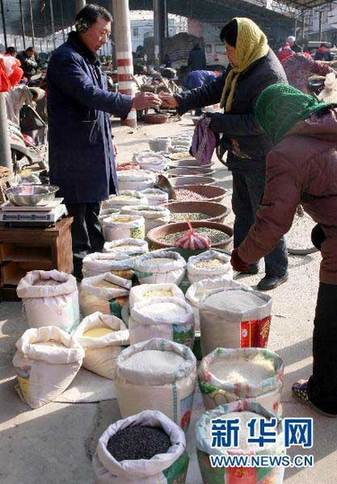|
 |
|
To make the Laba Congee for the upcoming Laba Festival, residents purchase cereals in a market in Baofeng County, Pingdingshan City, Henan Province on Jan. 10. (Photo by Gu Jun, Xinhua)
|
This year's Laba Festival, which falls on the eighth day of the 12th month of the Chinese lunar calendar, arrived on Tuesday. In China, the two most important traditions associated with the Laba Festival are eating Laba Congee, and praying for peace and good health in the coming year.
Laba Congee contains glutinous rice, red beans, millet, Chinese sorghum, dried lotus seeds, dried dates, chestnut meat, walnut meat, almonds, and peanuts. Another Laba food is Laba garlic, which is particularly popular in northern China. The Garlic is soaked in vinegar for twenty days starting from the Laba festival. The garlic and vinegar is then eaten with Chinese dumplings (or Jiaozi) during the Chinese Spring Festival. Garlic, or suan in Chinese, shares the same pronunciation with “calculating”, making it an omen of great wealth in the coming year.
The Chinese have a legend which explains how the Laba congee became so popular. When Sakyamuni was on his way into the high mountains on his quest for understanding and enlightenment, he grew tired and hungry. Exhausted from days of walking, he passed into unconsciousness by a river in India. A shepherdess found him there and fed him her lunch -- porridge made with beans and rice. Sakyamuni was thus able to continue his journey. After six years of strict discipline, he finally realized his dream of full enlightenment on the eighth day of the twelfth lunar month. Ever since, monks have prepared rice porridge on the eve and held a ceremony the following day, during which they chant sutras and offer porridge to Buddha. Thus, the tradition of eating Laba porridge has religious origins, though with the passing of time the food itself became a popular winter dish especially in cold northern China.
|